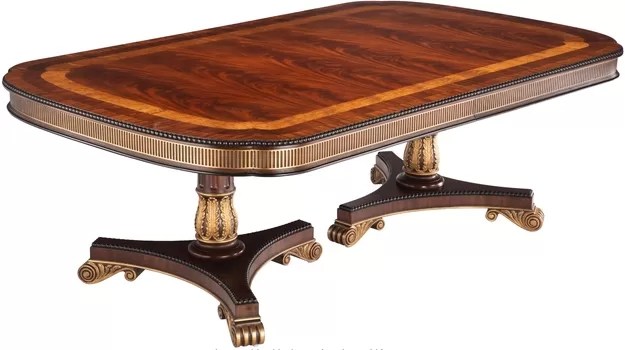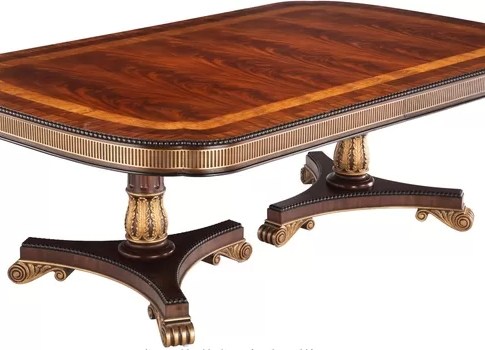Directoire furniture, which emerged during the transitional period of the French Revolution from 1795 to 1799, embodies a blend of neoclassical elegance and simplicity.
Named after the French Directory government, this style bridges the gap between the ornate Louis XVI and the opulent Empire styles. If you’re considering adding a piece of Directoire furniture to your collection, understanding its unique characteristics is essential.
Our guide to Directoire Furniture continues after this advertisement:
Looking for stylish, versatile, utilitarian furniture that is sought-after by collectors? Thinking 1950s Eames? Try 1790s France.
The Directoire style was established during a brief period between the French Revolution and the Napoleon era. The fallout after the Revolution left a weakened government with little funds and virtually no power to enforce laws.

A hastily formed group of leaders known as the Directory organized its rule around two unifying principals: maintaining and increasing its own economic and political power; and keeping the Bourbon monarchy out of power.
Each of those principals manifested themselves in the period’s styles of dress and design.
Directoire Furniture
Many craftsmen of the time joined the Revolution’s leaders in their celebration of Antiquity, mimicking the forms and styles of ornamentation found on Grecian and Roman vases and bas reliefs.
The antique Greek chair, with its broad, concave back, was the principal model for the Directoire style chair.
Jacques Louis David
It’s likely no one celebrated the Directoire style more than the artist Jacques Louis David. Already established as the pre-eminent artist of the Revolution, David quickly became the biggest promoter of the new furniture style. He regularly designed furniture for his portraits, and enlisted the respected craftsman George Jacob to construct those pieces.
A typical example of Directoire furniture is the day bed Jacob made for David’s portrait of Madame Recamier. The bed’s two graceful out-scrolled sides are indicative of the Directoire style.

Yet, despite the Directory’s intention, the Directoire style represented more of a transition than a clean break from the Louis XVI style.
The style is considered to be a much simpler version of the Louis XVI period. The straight lines are retained, as are many of the Greek and Roman-inspired design elements, such as lyres, stars, and diamonds. Those classical elements would come to dominate the Empire style of Napoleon’s reign.

But in contrast to the two eras it separated — Louis XVI and Empire — the Directory period was brief, and furniture production was limited.
That makes Directoire pieces scarce, though not necessarily more coveted by today’s collectors. No more so than other periods like Regence, Louis XV, or Louis XVI.
And its scarcity doesn’t mean higher prices either. Directoire pieces fetch nearly the same prices at auction as Louis XV and Louis XVI articles.
A Directoire chair from 1795 brought $2,990 at a recent Christie’s auction compared to a 1780 Louis XVI chair, which fetched $3,680.
Directoire furniture did go through something of a renaissance in the United States during the 1950s. Its somewhat utilitarian nature accounted for its broad appeal.
Because 70 percent of it is painted — usually gray or white — it has greater versatility than more ornate styles.
In addition, one of the most popular pieces of Directoire furniture — in the 1950s and today — is a mahogany dining room table, because it goes with different types of chairs.

Ultimately, what the style offers is perhaps the first glimpse of modern design; clean, straight lines, reduced ornamentation, and versatility.

More than simply a style of transition, Directoire furniture represents a peek into the future — much like the revolution that inspired it.
Incorporating Directoire Furniture into Your Home
Directoire furniture, with its timeless elegance and understated sophistication, can seamlessly blend into various interior styles. Pairing Directoire pieces with modern or contemporary furniture creates a balanced and eclectic look.
Using a Directoire chair, console table, or commode as a focal point in a room can highlight its historical significance. Complementing these pieces with fabrics and accessories in muted tones and classic patterns enhances the neoclassical charm of Directoire furniture.
The Essence of Directoire Furniture
The Directoire period was marked by political upheaval and social change, which is reflected in the furniture of the era.
Unlike the preceding Rococo and Baroque extravagance, Directoire furniture emphasizes more restrained and simplified forms. This shift towards a more subdued aesthetic is evident in several key design characteristics.
Neoclassical influence is a hallmark of Directoire furniture. Inspired by ancient Roman and Greek designs, this furniture style features clean lines, symmetrical shapes, and classical motifs such as laurel wreaths, lyres, and urns.
The decoration is notably simplified compared to previous styles, with fewer elaborate carvings and a greater emphasis on geometric patterns. The proportions of Directoire pieces are elegant and balanced, focusing on both functionality and form.

A Set of Four French Directoire Patinated and Gilt Bronze Candlesticks, circa 1795 sold for $8,125 in 2021
Key Motifs in Directoire
The motifs used in Directoire furniture are integral to its distinct aesthetic. Classical elements dominate, with common motifs including laurel wreaths, lyres, and urns.
These motifs are often carved into the wood or applied as decorative elements. The laurel wreath, for example, symbolizes victory and honor, while the lyre is a nod to classical music and arts.
Urns, another popular motif, represent classical antiquity and add a touch of historical grandeur.
Fluted legs are another characteristic feature of Directoire furniture.
Inspired by ancient columns, these legs are typically straight and feature vertical grooves that add a subtle decorative element.
This design not only enhances the visual appeal but also adds a sense of lightness and elegance to the furniture.
Geometric patterns are also prevalent in Directoire design. These patterns, often in the form of simple, clean lines and shapes, reflect the neoclassical influence and the era’s shift towards more straightforward, functional design.

Inlays and marquetry are sometimes used to create these geometric designs, adding contrast and visual interest without overwhelming the piece.
What to Look for When Buying Directoire Furniture
When purchasing Directoire furniture, authenticity is paramount. Researching the history and origin of a piece can provide valuable insights into its authenticity and value.
Provenance, or the documented history of ownership, can significantly enhance a piece’s value.
Authentic Directoire furniture often bears marks or labels from known cabinetmakers of the era, which can usually be found on the underside or inside of drawers.
Materials and craftsmanship are critical factors to consider. Directoire furniture was typically made from high-quality woods such as mahogany, walnut, and oak.
Examining the quality of the wood and looking for signs of repairs or replacements can provide clues about the piece’s authenticity. The construction of the furniture should also be scrutinized.
Authentic pieces often feature dovetail joints, a sign of quality craftsmanship, and hand-carved details that reflect skilled workmanship. Delicate inlays of contrasting woods or materials like brass should be intact and original.
The condition of the furniture is another important consideration. While some wear is expected given its age, extensive damage or poorly executed repairs can diminish its value.

Restoration work should be sympathetic to the original construction methods and materials. High-quality restoration can preserve the piece’s integrity, but poorly done work can detract from its value and aesthetic appeal.
Discovering Directoire Furniture: A Guide to Elegance and Craftsmanship
Directoire furniture represents a unique chapter in the history of design, reflecting the social and political changes of its time.
Whether you’re an avid collector or a newcomer to the world of antiques, understanding the hallmarks of this style will help you make informed and rewarding purchases. Embrace the elegance and simplicity of Directoire pieces to add a touch of historical sophistication to your home.
Directoire Fashion
Extravagant fashion — top hats, snug trousers, and high boots for the men; low necklines and high waistlines for the women reflected the Directory’s political excesses (some say corruption), while the furniture design mirrored the Directory’s desire to break away from all things Bourbon. That meant less ornamentation, not more.
Unlike the clothes, the furniture was notable for its simplicity. Its limited detail borrowed heavily from ancient Greek and Roman designs.

Directoire Revival Fashions 1888 1889 57 Patterns with Fashion Plates
Further Reading
Directoire Revival Fashions 1888-1889: 57 Patterns with Fashion Plates and Suggestions for Adaptation Paperback, 2010 by Frances Grimble
Modern Furniture Designs 1950-1980s: An International Review of Modern Furniture by Klaus-Jurgen Sembach
The Herman Miller Collection, 1952: Furniture Designed by George Nelson and Charles Eames, With Occasional Pieces by Isamu Noguchi, Peter Hvidt by Inc Herman Miller
Histoire Du Directoire De LA Republioue Francaise by Amable G. Barante
Related Feature Stories
The Clam Chair: An Iconic Design by Phillip Arctander
Louis XV And XVI Furniture: Understanding The Obsession
Cane Wicker & Rattan Furniture
News, Information & Buying Guides on Antique Furniture




